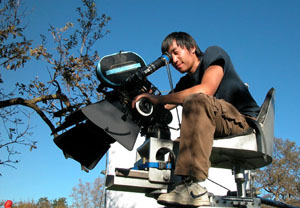Extreme Long Shot:
An extreme long shot is taken from much further than any of the images are taken. It is used for scene-setting in movies.
Very Long Shot:
A very long shot includes all the nearby objects/people and is used mainly in horror movies.
Long Shot:
A long shot is used to show the character from head to toe. Head being right near the top of the frame and the feet being right at the bottom. T
Medium Long shot, Medium Shot and Medium Close up:
The medium long shot shows the character from head to knee. This allows for us to see their body language firmly. The medium shot is from hip up to head. This allows for us to see their facial expressions and is used highly frequently in many movies during scenes with a lot of dialogue. This is the exact same for the Medium close up but the medium close up is from chest to head.
Close Up and Big Close up:
The close up is used for us to identify how the character is feeling. This is from their facial expressions. Directors use this shot mostly during dialogued scenes as we can see and hear the characters talking. From this we can see a lot.
Extreme Close Up:
A extreme close up is used to focus on one aspect of the face. It could be the eyes, nose or lips. From this no background detail is revealed. Extreme close up's are very hard to film as one little movement of the camera could result in the whole shot being ruined
Camera Angles
The relationship between the camera and the object being photographed (ie the ANGLE) gives emotional information to an audience, and guides their judgment about the character or object in shot. The more extreme the angle (ie the further away it is from eye left), the more symbolic and heavily-loaded the shot.
1. The Bird's-Eye view
This shows a scene from directly overhead, a very unnatural and strange angle. Familiar objects viewed from this angle might seem totally unrecognisable at first (umbrellas in a crowd, dancers' legs). This shot does, however, put the audience in a godlike position, looking down on the action. People can be made to look insignificant, ant-like, part of a wider scheme of things. Hitchcock (and his admirers, like Brian de Palma) is fond of this style of shot.

A cameraman, raised above the action, gets a high angle shot
2. High Angle
Not so extreme as a bird's eye view. The camera is elevated above the action using a crane to give a general overview. High angles make the object photographed seem smaller, and less significant (or scary). The object or character often gets swallowed up by their setting - they become part of a wider picture.
3. Eye Level
A fairly neutral shot; the camera is positioned as though it is a human actually observing a scene, so that eg actors' heads are on a level with the focus. The camera will be placed approximately five to six feet from the ground.
4. Low Angle
These increase height (useful for short actors like Tom Cruise or James McAvoy) and give a sense of speeded motion. Low angles help give a sense of confusion to a viewer, of powerlessness within the action of a scene. The background of a low angle shot will tend to be just sky or ceiling, the lack of detail about the setting adding to the disorientation of the viewer. The added height of the object may make it inspire fear and insecurity in the viewer, who is psychologically dominated by the figure on the screen.
5. Oblique/Canted Angle
Sometimes the camera is tilted (ie is not placed horizontal to floor level), to suggest imbalance, transition and instability (very popular in horror movies). This technique is used to suggest POINT-OF-View shots (ie when the camera becomes the 'eyes' of one particular character,seeing what they see — a hand held camera is often used for this.

No comments:
Post a Comment